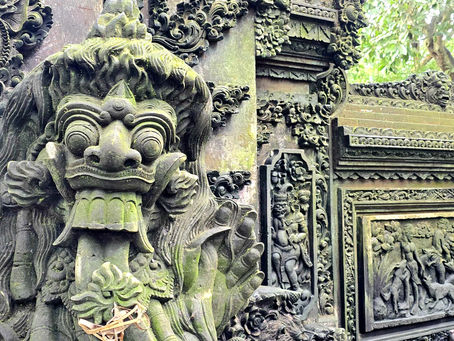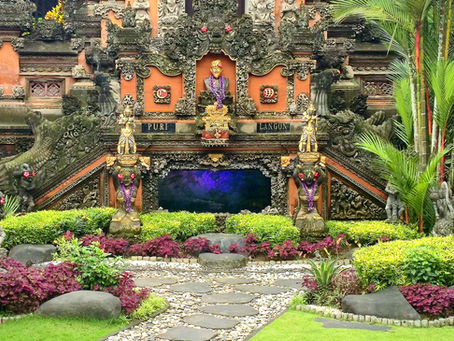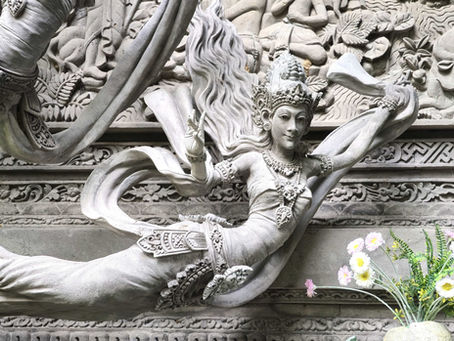top of page

GLOBAL SHANANIGANS

Search


Sacred Flames - Ubud’s Cremation Temple
Perched on the shadowed fringe of Ubud’s Sacred Monkey Forest, Pura Prajapati stands as a silent witness to centuries of life, death and the thin veil between them. Built around 1350AD, this moss cloaked cremation temple is one of the forest’s three ancient sanctuaries, yet its presence carries a weight far beyond stone and mortar.
Shannon


Goa Gajah Temple
Mystery surrounds the true origins of Goa Gajah, a 9th century cave temple complex near Ubud in central Bali. Rediscovered by Dutch archaeologists in 1923 after centuries hidden beneath dense vegetation, the site holds no actual link to elephants, despite its name. The term “Elephant Cave” likely evolved from Lwa Gajah, an old name associated with the nearby river, not from any animal symbolism found within the temple itself.
Shannon


Yeh Pulu - Water of the Stone Jar
Hidden in a lonely ravine between the Petanu and Pakrisan Rivers, the ruins of this unique 14th-century rock relief lay buried for centuries under volcanic eruptions and vegetation. The site was excavated by Dutch authorities in 1925 and in 1949, a stone gutter was cemented on top in order to drain off water, to prevent erosion and vegetation from taking hold, revealing even more of the stone mural.
Shannon


Gunung Kawi Tampaksiring - The Mountain of Lost Kings
Carved into the rock cliffs on both sides of the Pakrisan River, this 11th century temple site and funerary complex is of profound historical and spiritual significance to the Balinese people. The name Gunung Kawi translates to the "Mountain of Poetry" but it is also affectionately referred to as the Valley of the Kings.
Shannon


The Holy Springs of Tirta Empul
Founded in 962AD during the Warmadewa dynasty, Tirta Empul is one of Bali’s most sacred temples, located in the cool highlands of Tampaksiring near Manukaya village. Its name, which means "holy water spring," is derived from a natural spring that bubbles up into the temple’s central pool and continues to feed the nearby Pakerisan River. This revered site is dedicated to Vishnu, the Hindu God of Water and Preservation
Shannon


Goa Lawah Bat Cave Temple
On Bali’s southeastern coast, Goa Lawah Bat Cave Temple stands out as a powerful spiritual site where myth and nature collide. With thousands of bats roosting above its shrines, this atmospheric temple offers a raw glimpse into the island’s ancient traditions.
Shannon


Kanto Lampo Waterfall
Shaped by both chance and design, one of Bali’s most unexpected natural wonders is Kanto Lampo Waterfall. Unlike the island’s ancient cascades that have poured down jungle cliffs for centuries, this waterfall is a relatively recent creation. In the early 2010s, adjustments to a local irrigation system redirected water across a rocky cliffside and over time the flow carved its way over volcanic stone, giving rise to the unique cascade we see today.
Shannon


Puri Langon Temple
Puri Langon is a privately owned royal compound located in central Ubud. It is the personal residence of Tjokorda Ngurah Suyadnya, better known as Cok Wah, a respected figure in the Ubud royal family. Though it remains a functioning private home, Puri Langon is open to the public free of charge, offering rare access to a lived-in royal space that continues to serve spiritual and cultural functions within the community.
Shannon


Taman Dedari - Dine Among the Divine
Born from the legend of Resi Markandeya’s vision of angelic dancers over the Ayung River, Taman Dedari blends myth and appetite in equal measure. Here, guests savour Balinese flavours in a riverside setting guarded by monumental stone Dedari, the celestial maidens of old.
Shannon
bottom of page